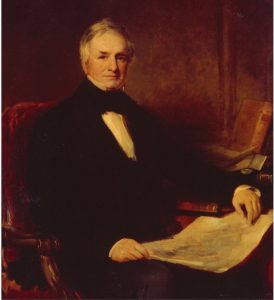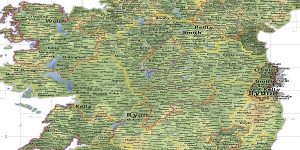No matter how familiar a record source appears to be, it can always surprise.

It took me three decades of staring at Griffith’s Valuation, the main mid-19th century Irish census substitute (see askaboutireland.ie/griffith-valuation), to realise that its place name spellings are all identical to those in the standard reference, the 1851 Townlands Index. As anyone who has dealt with the infuriating volatility of Irish townland spellings will know, this can’t be a coincidence. The only conclusion is that both the Index and Griffith’s share the Ordnance Survey as a common standard source.
The practical implication for a researcher is that once the 1851 Townlands Index spelling is identified, that’s how the place name should appear in Griffith’s. That’s what made it possible to create a direct click-through from place name to Griffith’s on this site – see the places listed for Kilkeevin, for example.
So what about the other great spelling-variant problem, Irish surnames? Is there any evidence that Griffith’s standardised surnames as well as place names? Yes and no. For literate individuals, the rule seems to have been that the version recorded should match that supplied by the individual himself. After all, Griffith’s is a tax survey. A misspelt surname is an obvious loophole: you have to be sure you have the right goose before you can start plucking.

For the illiterate or Irish speakers, the same motivation seems to have produced a limited local form of standardisation. While the front-line valuers might record a name as “Curlie”, “Curly” or “Corly”, the higher-ups responsible for the published version would correct to a single standard. So all who could not write their own name in English became “Curley”.
It has to be said that this is not a very useful research tool – the advice must continue to be simply “cast the net as wide as possible”. But for larger-scale population and surname studies, that localised standardisation has one useful side effect. It exaggerates the visible concentrations of anglicised surnames, providing useful prima facie evidence of clan or sept origins.
Have a look at all those Curleys, for example.
Very useful and timely post, John.
(1) Can I ask your advice about place names: what do you do to identify places the name of which are neither in the Townland Index nor Griffith? I spent weeks trying to find a place that appeared in baptism record as Cootswood/s – or once, just Woods. It turned out to be the townland of Adoon, but the name had been “standardised” out by the Ordnance Survey, or whoever. Have you any advice about sources for these types of local names?
(2) Surnames. My g-grandfather appeared successively as Degnan (1841), Duignan (LEC Rental), Dignam (Griffith), Deignan (births of some of his children), and Duignan (baptisms of some of his children). My grandfather and his siblings used the spelling Duignan and that spelling is used by all of us in the current generation – though the pronunciation (deg-nan, diet-nan, depending on where we live) ! I suspect that the local NT had a lot to do with standardising surname spellings in the late 19th/early 20th centuries.
Fiona, I reccomend the Duignan One Name Study Group on Facebook
Good idea Fiona especially if can also include those with a Duigan or Digan family name like those on my Mum’s side. There must have been some event or influence which introduced the “middle n” at some stage into the earlier versions of the name and presumably some genealogists or historians know why!
Mike Shone, New Zealand
Hello Thomas – thank you for the recommendation, because that’s my FB group …
Hi Fiona, Have you tried Placenames Database of Ireland? I’m guessing you have, but it can take some imagination and experimentation to find some things, especially if the name you’re looking for is only seen in their historical documentation for a place. It would be handy if they would enter the historical names into a searchable field.
Look at the OS map of the area, there cannot be too many townlands that somewhat resemble the clerical spelling.
Hi Fiona. Look for Cooteswoods, Cootes Woods, Cookswoods, Cootswoods
There is an 1834 Tithe map which has Cookswoods drawn adjacent to Adoon Lough/Lake.
https://www.irelandgenweb.com/irllet/records/ClooneTithes.htm
http://homepage.eircom.net/~aughavascloone/townlands_of_cloone.htm
Eric
Thanks for that that may explain a few things for me!
Interesting that you should select the Surname Curley John! I’ve been hunting my Curley ancestors among many others for some time now.. murder to pin point where they came from.. My Curley’s married into Carroll’s.. that never narrowed it down much for me either as they’re just as numerous across Ireland.. Oh the joys.. ha-ha
Hello,
I do not understad how there are 4 different townlands called Clooncunny within a very short distance from each.
Clooncunny 394 Roscommon Roscommon Elphin Strokestown Connaught
Clooncunny 166 Sligo Leyny Achonry Tobercurry Connaught
Clooncunny 153 Sligo Coolavin Killaraght Boyle Connaught
Clooncunny 324 Sligo Corran Kilshalvy Boyle Connaught
Regards, Dianne
For similar reasons there several places called ‘Meadow’ in Dallas.
https://en.wikipedia.org/wiki/List_of_neighborhoods_in_Dallas
I don’t mean to whine. But, was there really a need to have so many townlands namd Cartron in one country?
Why are there so many called Washington in the USA ?
I often wonder about my surname “Kenney” it is more often spelled “Kenny”. It appears that my family arrived in America sometime in the late 1700’s from Ireland and settled in eastern Pennsylvania.
John, I believe I have one place name that differs in Griffith’s Valuation to the 1851 Townlands Index.
In 1851 Townlands Index – Corranewy is in the Electoral Division of Aghabog, in Civil Parish of Ematris, in the Barony of Dartree, in the County of Monaghan
In Griffith’s Valuation – Corranervy Monaghan Dartree Ematris Corranervy and Corranewy cannot be found.
Looking at the maps each site provides they are clearly the same townland.
This means that the link for Corranewy on your Ematris civil parish, Monaghan web page fails.
Made it hard work locating Moore of Corraneway!
Were townland boundaries also standardized or changed as part of this process in the 19th century? For example, I have an ancestor who appears in the Tithe Applotments in Ahanasack townland in Galbally in Limerick. But twenty yeard later in Griffith’s Valuation, Ahanasack no longer exists.
Many local and traditional names were simply ignored in the standardisation process even though they remained in local use. The original Ordnance Survey six-inch maps recorded many of these ‘sub-townland’ denominations and there are indexes on microfilm in the National Library:
Pos. 4621 Cork, Clare, Kerry.
Pos. 4622 Tipperary, Galway, Leitrim, Mayo.
Pos. 4623 Sligo, Antrim, Armagh, Cavan, Donegal, Roscommon, Waterford, Limerick.
Pos. 4624 Kildare, Carlow, Down, Dublin, Fermanagh, Kilkenny, Offaly, Longford, Louth, Meath, Monaghan.
Pos. 4625 Laois, Tyrone, Westmeath, Wexford, Wicklow and Derry/Londonderry.
Looking for family surname Tuttle
Try https://www.johngrenham.com/findasurname.php?surname=Tuttle
Mike, there are other names too and I think your name Duigan, might be Doogan or Duggan nowadays. Digan might be Deegan. This is a guess.
The n letter in Duignan is significant, so they would not have dropped it so easily or at all. Duignan comes from the Irish, Ó Duígeannáin All the Irish language surnames had to be anglicised under English rule. They are the surnames we use today but they all have an Irish language equivalent which those of us who speak Irish, use. I wonder if we are the only people in the world who have two legal surnames.